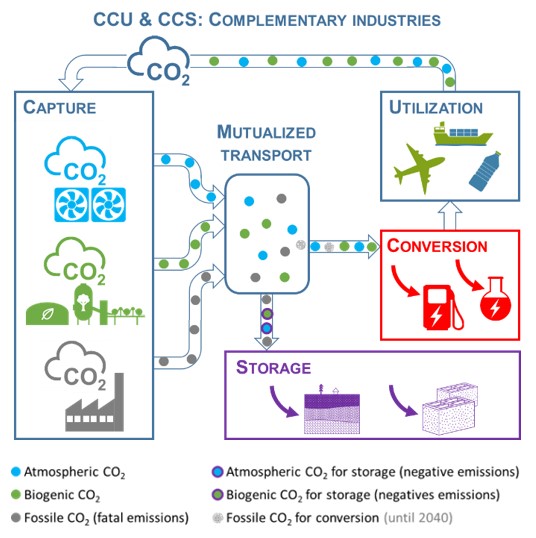28.05.2025
5 minutes of reading

E-FUELs: CHALLENGES AND opportunitIES
Focus n°6
CCU and CCS: two complementary industries
The industrial carbon management strategy published by the European Commission in February 20241 is based on three pathways: carbon capture and storage (CCS), carbon capture and utilization (CCU), and carbon dioxide removal (CDR) (not addressed in this fact sheet). CCS aims to capture and permanently store CO2 in a technological carbon sink approach. CCU aims to valorize the captured CO2 in a circular carbon economy approach. And CDR aims to remove CO2 from the atmosphere and store it permanently.
Both CCS and CCU industries are necessary and complementary with a common goal of carbon neutrality.
- They rely on a common technological building block: CO2 capture. Transport infrastructure and the development of distribution hubs can also be shared, with a common CO2 purity level to be defined. The downstream components (storage or conversion) are specific to each industry.
- The services provided by the two industries are different and include:
- A decarbonization goal for fossil CO2 emitters through CCS and the possibility of negative emissions by treating biogenic or atmospheric CO2,
- A defossilization goal for CCU through the production of synthetic fuels or molecules as substitutes for products derived from fossil resources.
- A decarbonization goal for fossil CO2 emitters through CCS and the possibility of negative emissions by treating biogenic or atmospheric CO2,
The two industries are expected to develop in parallel, with a pace imposed by regulations and national and European roadmaps. These deployments can only be achieved through an integrated vision that relies on both efforts of sobriety and the intensification of net zero technologies (electrification, use of low-carbon hydrogen, energy efficiency, etc.). By 2050, the European Commission anticipates a need to capture 450 Mt of CO2 in Europe, with 55% to be stored and 45% to be utilized. In France, as mentioned in focus #1, with a need to convert about 15 Mt of CO2 into e-SAF by 2050, the volumes of CO2 required by the CCU industry are of the same order of magnitude as those targeted by the CCS industry (15-20 Mt of CO2).

Trade-offs will certainly be necessary, particularly in terms of territorial and societal challenges:
- What will be the balance between CCS and CCU to meet the decarbonization trajectories within different industrial basins, for example, based on emission levels and the territorial infrastructure?
- What will be the social and societal appropriations of the CCU and CCS value chains?
- How the allocation and supply of critical resources will be structured (for example, electricity, CO2, biomass)?
- What will be the geographical and temporal accessibility of storage areas?
The regulatory framework is thus expected to be precised in the coming years
1 COM (2024) 62, Towards an ambitious Industrial Carbon Management for the EU, 6.2.2024
From the perspective of achieving carbon neutrality, the development and deployment of both industries must be based on multi-criteria analysis (including techno-economic and LCA) across the entire value chain to ensure that solutions will be sized to the needs. R&D activities of CEA and IFPEN contribute to the development of all the technological building blocks of these two industries at different maturity levels and their integration into complete value chains.
Download the pdf file (250 ko)
E-fuels: challenges and opportunities - Glossary
ADEME: French energy transition agency (www.ademe.fr)
ANCRE: French National Alliance of Coordination of Research for Energy
CBAM: Carbon Border Adjustment Mechanism






